Classification of Minerals (3. Oxides and Hydroxides, 4. Halides)
3. Oxides and Sulfides
Oxygen combines with one or more metals to form oxides. Oxides are grouped into simple and complex oxides. The simple oxides are compounds of one metal and oxygen (cuprite, zincite, corundum, hematite, rutile and uraninite), while the complex oxides are those of more than one metal and oxygen (spinel, magnetite, franklinite and chromite). The oxide minerals are relatively dense, hard and refractory.
When hydrogen is one of the cations and present as hydroxyl, they are called hydroxides. Like oxides, hydroxides also divided into simple and complex groups. Brucite, manganite, romanechite, diaspore and goethite belong to the hydroxides. The hydroxide minerals are relatively soft, low in specific gravity and brittle.

FrankliniteNew Jersey, USA
Franklinite is an ore mineral for zinc and manganese. It looks like magnetite, but is only slightly magnetic and has a dark brown streak.
4. Halides
Halides are formed by ionic bonds between metals and large halogen ions such as F, Cl, Br and I which have a charge of –1. Halides dissolve easily in water. Halides have low hardness, high melting point and low thermal conductivity. They are generally nonconductors of electricity.
Halite, the most common halide mineral, is cubic in form, easily dissolves in water, and is a major component of sea water that occupies three quarters of the earth's surface. Fluorite is named after its fluorescence. Sylvite has an identical occurrence with halite and is used for the manufacture of fertilizer. Some of the other halides are cerargyrite, atacamite and carnalite.

HaliteCalifornia, USA
Cubic crystals are halite, which grew on the skull of a bison in a saline lake.

Manganese nodule Deep sea, East Pacific
Manganese nodules are masses of various hydroxides formed in deep sea floor. They contain a variety of useful metals such as manganese, copper, nickel and cobalt.

Cuprite Zaire
Cuprite, a kind of simple oxide, is red in color. It is a minor ore mineral of copper.
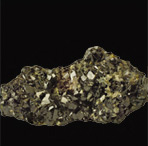
Cassiterite Bolivia
Cassiterite, a kind of simple oxide, is a main ore mineral of tin. It is characterized by high specific gravity and adamantine luster.
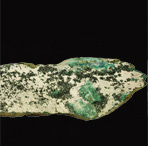
Atacamite Chile
Atacamite, named after Atacama in Chile, often occurs as a supergene mineral in the oxidized zone of copper deposits. It is dark green in color.
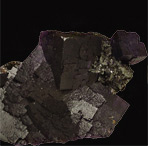
Fluorite Illinois, USA
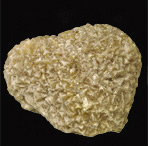
Fluorite Jecheon, Korea
Fluorite is usually found in hydrothermal veins. It is mainly used in the production of hydrofluoric acid and as a flux in the manufacture of steel.
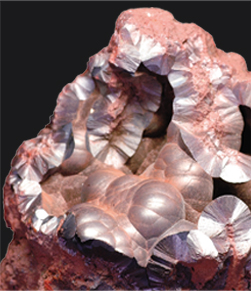
Hematite North Korea
Hematite, together with magnetite, is the main ore mineral of iron. Unlike magnetite, it shows magnetism only in a reducing flame, but loses it again when heated in an oxidizing flame. Its Mohs hardness is about 5-6. It shows metallic luster in crystals but is dull in earthy varieties. Its streak is light to dark red, and changes into black on heating.
Crystals are usually tabular, rhombohedral or pyramidal. Rosette-like tabular hematite forms 'iron roses'. Hematite, shaped as in the picture, is called reniform or 'kidney ore'.
An old occidental legend says that the blood of soldiers shed in battle soaked into the land and formed large red hematite deposits.

Fluorite Shinpo Mine, Chuncheon, Korea
Fluorite was named after its fluorescence under ultraviolet light. It is transparent to translucent and has a vitreous luster. Its color varies widely: purple, greenish blue, violet blue, wine yellow, green, sky blue, bluish black or brown. It is one of the minerals that show varied colors and crystal forms.
Its cubic, hexoctahedral or tetrahexahedral forms can combine to show various crystal forms. It has a characteristic octahedral cleavage. Twins are common.